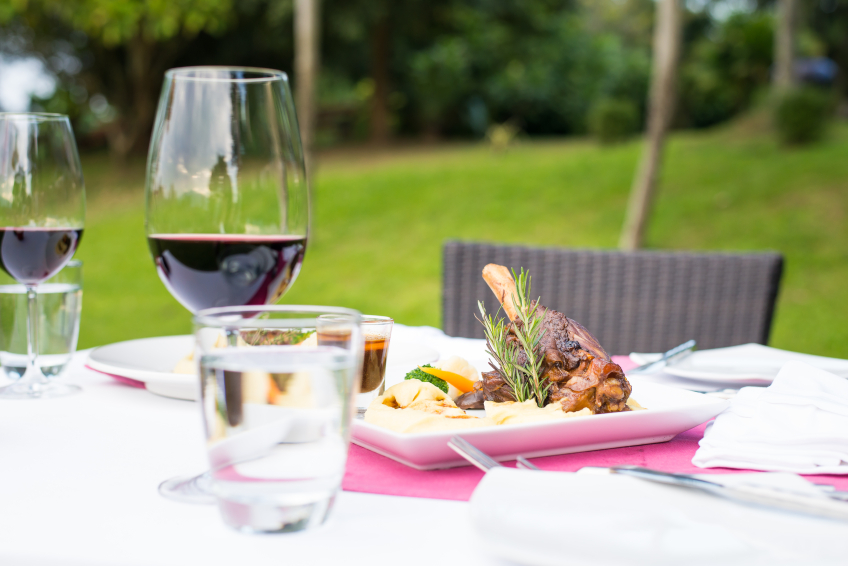Whether your home is a house in the suburbs or a high rise in the city, taking advantage of the outdoors is a great way to expand your livable space. If you are working with a large backyard, your possibilities may be endless, but even the tiniest balcony can be transformed into a functional area. There is nothing quite like enjoying a delicious meal al fresco, so here are a few tips to consider when designing an outdoor dining space.
Determine Your Function
Depending on the square footage of your outdoor area, consider what you will be using it for. Are you creating a dining space on a cramped balcony, or do you have a sprawling back yard with room for several areas? Smaller spaces can be tricky, so try to find furniture that can double as storage, like a bench with space beneath or a table with drawers or an extra shelf. For larger spaces, consider separating areas with rugs or using potted plants to establish borders between the dining and lounging spaces.
If dining will be one of the main uses of your outdoor space, be sure to consider proximity to the kitchen or grill. Having a clear path between the cooking area and the dining area will make serving much easier and help prevent trips, drops and spills.
Find Your Color Scheme
Consider what your focal point will be to help determine your color scheme. If your outdoor space overlooks the ocean or a beautiful landscape, then choosing neutral materials will create fewer distractions from the view. Alternatively, if you’re working with an urban setting, bring in a bit of color with potted plants and vibrant seat cushions or pillows. Ultimately, your space should be a reflection of your own style, but should also complement the surroundings.
Know Your Environment
With many different materials to choose from, selecting the right outdoor furniture can be tough, but considering your environment is a great place to begin narrowing down the list. If your space gets a lot of direct sunlight, metal furniture may not be your best choice as it can get hot and uncomfortable to touch. Additionally, if you are near the ocean, salt water in the air can be harsh on metal surfaces and require additional treatment and cleaning to maintain.
If you live in an area that experiences all the major seasons, you will want to consider if you will need to store your furniture for the winter. Plastic, resin, or wicker patio furniture can be a bit lighter weight than other materials and easier to put away for the off season.
Know Your Surroundings
Is your outdoor space small and intimate or large and sprawling? For smaller spaces, less can be much more. Be careful not to force a small space into something it can’t handle, like cramming an eight-seat table into a 4-seat space. Bistro tables can be an excellent fit for city balconies and smaller patios as they don’t take up too much space and can be easily moved around. Forcing too much furniture into a small space will make it feel even smaller and may deter you from enjoying it.
For larger spaces, be careful not to overdo it! Ask yourself what you are most likely to use the space for before you plan a 50-person dinner party. Large spaces are often best utilized by sectioning into several areas. For example, an outdoor dining space, a lounge area, room for the kids to play, and a pool can coexist in a very comfortable way by sectioning each area as if it were a room inside your home. Create obvious walkways between each area, and utilize area rugs, planters or potted plants to give the illusion of borders for each area. If you need a bit of privacy, a trellis covered in vines is the perfect divider to create a more intimate outdoor dining area.
Know Your Audience
Is your outdoor dining space for you and your spouse, or do you have a large family or entertain frequently? If you pride yourself as the host with the most, make sure your outdoor dining layout allows for a smooth cooking and entertaining experience. If your grill is the primary cooking space, make sure it is safely separated from the crowd, but also close enough that you can cook and entertain at the same time. If you plan to mostly cook inside, try to plan the dining space in close proximity to the indoor kitchen to avoid long trips back and forth and easy access to the refrigerator.
Have Fun with It
There are a million different ways to design an outdoor space and it really just boils down to your own personal style. Inspiration is often just a few clicks away, or you can view hundreds of patio dining sets at PatioLiving.com.








